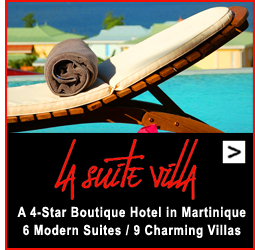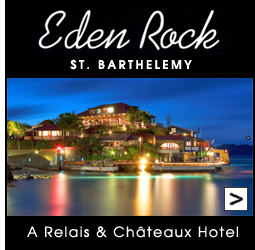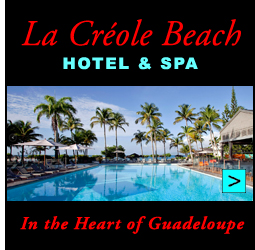Martinique - Description, Beaches, History
Martinique is truly ''a little bit of France in the Caribbean." It exudes a distinctly French ambiance in the excellence of its cuisine, the style of its population and the beauty of its language. Yet Martinique has a unique cachet all its own, an endearing West Indian warmth in its personality, a special spice in its music, its dance, its local dishes and its way of life.

The beauty of Martinique is everywhere. It can be seen in its attractive residents (population 375,000), its beaches and its spectacular topography. However, it is the lush vegetation of the "Island of Flowers" that takes your breath away. Hibiscus, frangipani, bougainvillea, anthuriums, poinsettias, orchids and exotic hardwoods are found throughout the island. There are fields rich in guava, mango and papaya as well as vast plantations of bananas, pineapple, sugarcane, cinnamon and coffee. In the tropical rainforests of Martinique, ferns grow as tall as trees and green comes in a thousand different shades.
It is also an island rich with contrasts. The northern part of Martinique features dense rain forest, mountain peaks, a volcano and dark sand beaches. The southern areas are much drier and flatter with magnificent white sand beaches. There are charming fishing villages and commercial developments, tiny guest houses and large, upscale resorts. All in all, Martinique offers something for everyone.
The capital city of Fort-de-France, built like an amphitheater around the yacht-filled harbor, is backed by luxuriant mountains and is one of the most memorable, picturesque settings in the Caribbean. It is a city of approximately 90,000, with narrow balconied streets, busy and bustling by day, generally quiet by night.
Martinique is 3275 km (1965 mi) from New York, 2450 km (1470 mi) from Miami, 3783 km (2270 mi) from Montreal, 708 km (425 mi) from San Juan and 7102 km (4261 mi) from Paris. The island covers 1105 sq km (425 sq mi), is 83 km (50 mi) long and 37 km (22 mi) wide.
BEACHES
The incredible beaches of Martinique come in many different varieties. On the west coast, there are numerous white sand beaches south of Fort-de-France, while the northern beaches (such as those at Carbet and St. Pierre) are darker due to their volcanic origins. On the eastern / Atlantic coast, the coastline tends to be more rugged except on the Caravelle Peninsula and at Anse Azérot, Cap Macré and Grande Anse Macabou where the waters are usually calm and inviting.
The famous Plage des Salines is in the south, a short drive from Ste. Anne, with tall coconut palms and a mile of dazzling white sand. During the summer holidays and weekends, it is often busy with families and children; during the week, it is usually quiet and less crowded. Other lovely Martinique beaches in the south include those at Ste. Anne, Ste. Luce, Cap Chevalier, Le Diamant (with the famous Diamond Rock offshore) and Anses d'Arlets.
There are no designated clothing-optional beaches on Martinique, although topless sunning and swimming is common at hotel pools and beaches near hotels. Public beaches do not as a rule have changing cabins or showers. Some hotels charge non-guests for the use of lockers and changing cabanas.
A BRIEF HISTORY
Columbus sighted Martinique in 1493, but did not go ashore until another voyage in 1502. At that time, the island was inhabited by the Carib Indians who had already exterminated the Arawaks. Originally known as Madinina, Columbus renamed the island Martinica in honor of St. Martin.
The French arrived to claim the island and begin permanent settlement there in 1635. They began to cultivate sugar cane and import slaves from Africa. As forests were cleared to make room for sugar plantations, fierce battles with the Carib Indians ensued. With the treaty of 1660, the Caribs agreed to occupy only the Atlantic side of Martinique. This peace was short-lived, however, and they were exterminated or forced off the island shortly thereafter.
The English occupied the island in 1782 but returned it the following year in exchange for Canada. They invaded and held the island once again from 1794 to 1815, when it was finally returned to the French.
In 1830, a ship capsized in rough weather near Anse Caffard. Of the 46 bodies recovered, all but four were Africans destined for the illicit slave trade. The tragic event is honored in a moving memorial near Diamant created by local artist Laurent Valère featuring 15 massive concrete statues.
Victor Schoelcher, a French minister for overseas possessions, convinced the government to sign an Emancipation Proclamation in 1848 ending slavery in the French West Indies.
On March 8, 1902, came the most devastating natural disaster in Caribbean history; the Mont Pelée volcano erupted, destroying the city of St. Pierre and claiming the lives of all but one of its 30,000 inhabitants. As a result, the capital of Martinique was permanently moved to Fort-de-France.
It is also an island rich with contrasts. The northern part of Martinique features dense rain forest, mountain peaks, a volcano and dark sand beaches. The southern areas are much drier and flatter with magnificent white sand beaches. There are charming fishing villages and commercial developments, tiny guest houses and large, upscale resorts. All in all, Martinique offers something for everyone.
The capital city of Fort-de-France, built like an amphitheater around the yacht-filled harbor, is backed by luxuriant mountains and is one of the most memorable, picturesque settings in the Caribbean. It is a city of approximately 90,000, with narrow balconied streets, busy and bustling by day, generally quiet by night.
Martinique is 3275 km (1965 mi) from New York, 2450 km (1470 mi) from Miami, 3783 km (2270 mi) from Montreal, 708 km (425 mi) from San Juan and 7102 km (4261 mi) from Paris. The island covers 1105 sq km (425 sq mi), is 83 km (50 mi) long and 37 km (22 mi) wide.
BEACHES
The incredible beaches of Martinique come in many different varieties. On the west coast, there are numerous white sand beaches south of Fort-de-France, while the northern beaches (such as those at Carbet and St. Pierre) are darker due to their volcanic origins. On the eastern / Atlantic coast, the coastline tends to be more rugged except on the Caravelle Peninsula and at Anse Azérot, Cap Macré and Grande Anse Macabou where the waters are usually calm and inviting.
The famous Plage des Salines is in the south, a short drive from Ste. Anne, with tall coconut palms and a mile of dazzling white sand. During the summer holidays and weekends, it is often busy with families and children; during the week, it is usually quiet and less crowded. Other lovely Martinique beaches in the south include those at Ste. Anne, Ste. Luce, Cap Chevalier, Le Diamant (with the famous Diamond Rock offshore) and Anses d'Arlets.
There are no designated clothing-optional beaches on Martinique, although topless sunning and swimming is common at hotel pools and beaches near hotels. Public beaches do not as a rule have changing cabins or showers. Some hotels charge non-guests for the use of lockers and changing cabanas.
A BRIEF HISTORY
Columbus sighted Martinique in 1493, but did not go ashore until another voyage in 1502. At that time, the island was inhabited by the Carib Indians who had already exterminated the Arawaks. Originally known as Madinina, Columbus renamed the island Martinica in honor of St. Martin.
The French arrived to claim the island and begin permanent settlement there in 1635. They began to cultivate sugar cane and import slaves from Africa. As forests were cleared to make room for sugar plantations, fierce battles with the Carib Indians ensued. With the treaty of 1660, the Caribs agreed to occupy only the Atlantic side of Martinique. This peace was short-lived, however, and they were exterminated or forced off the island shortly thereafter.
The English occupied the island in 1782 but returned it the following year in exchange for Canada. They invaded and held the island once again from 1794 to 1815, when it was finally returned to the French.
In 1830, a ship capsized in rough weather near Anse Caffard. Of the 46 bodies recovered, all but four were Africans destined for the illicit slave trade. The tragic event is honored in a moving memorial near Diamant created by local artist Laurent Valère featuring 15 massive concrete statues.
Victor Schoelcher, a French minister for overseas possessions, convinced the government to sign an Emancipation Proclamation in 1848 ending slavery in the French West Indies.
On March 8, 1902, came the most devastating natural disaster in Caribbean history; the Mont Pelée volcano erupted, destroying the city of St. Pierre and claiming the lives of all but one of its 30,000 inhabitants. As a result, the capital of Martinique was permanently moved to Fort-de-France.

The beauty of Martinique is everywhere. It can be seen in its attractive residents (population 375,000), its beaches and its spectacular topography. However, it is the lush vegetation of the "Island of Flowers" that takes your breath away. Hibiscus, frangipani, bougainvillea, anthuriums, poinsettias, orchids and exotic hardwoods are found throughout the island. There are fields rich in guava, mango and papaya as well as vast plantations of bananas, pineapple, sugarcane, cinnamon and coffee. In the tropical rainforests of Martinique, ferns grow as tall as trees and green comes in a thousand different shades.
It is also an island rich with contrasts. The northern part of Martinique features dense rain forest, mountain peaks, a volcano and dark sand beaches. The southern areas are much drier and flatter with magnificent white sand beaches. There are charming fishing villages and commercial developments, tiny guest houses and large, upscale resorts. All in all, Martinique offers something for everyone.
The capital city of Fort-de-France, built like an amphitheater around the yacht-filled harbor, is backed by luxuriant mountains and is one of the most memorable, picturesque settings in the Caribbean. It is a city of approximately 90,000, with narrow balconied streets, busy and bustling by day, generally quiet by night.
Martinique is 3275 km (1965 mi) from New York, 2450 km (1470 mi) from Miami, 3783 km (2270 mi) from Montreal, 708 km (425 mi) from San Juan and 7102 km (4261 mi) from Paris. The island covers 1105 sq km (425 sq mi), is 83 km (50 mi) long and 37 km (22 mi) wide.
BEACHES
The incredible beaches of Martinique come in many different varieties. On the west coast, there are numerous white sand beaches south of Fort-de-France, while the northern beaches (such as those at Carbet and St. Pierre) are darker due to their volcanic origins. On the eastern / Atlantic coast, the coastline tends to be more rugged except on the Caravelle Peninsula and at Anse Azérot, Cap Macré and Grande Anse Macabou where the waters are usually calm and inviting.
The famous Plage des Salines is in the south, a short drive from Ste. Anne, with tall coconut palms and a mile of dazzling white sand. During the summer holidays and weekends, it is often busy with families and children; during the week, it is usually quiet and less crowded. Other lovely Martinique beaches in the south include those at Ste. Anne, Ste. Luce, Cap Chevalier, Le Diamant (with the famous Diamond Rock offshore) and Anses d'Arlets.
There are no designated clothing-optional beaches on Martinique, although topless sunning and swimming is common at hotel pools and beaches near hotels. Public beaches do not as a rule have changing cabins or showers. Some hotels charge non-guests for the use of lockers and changing cabanas.
A BRIEF HISTORY
Columbus sighted Martinique in 1493, but did not go ashore until another voyage in 1502. At that time, the island was inhabited by the Carib Indians who had already exterminated the Arawaks. Originally known as Madinina, Columbus renamed the island Martinica in honor of St. Martin.
The French arrived to claim the island and begin permanent settlement there in 1635. They began to cultivate sugar cane and import slaves from Africa. As forests were cleared to make room for sugar plantations, fierce battles with the Carib Indians ensued. With the treaty of 1660, the Caribs agreed to occupy only the Atlantic side of Martinique. This peace was short-lived, however, and they were exterminated or forced off the island shortly thereafter.
The English occupied the island in 1782 but returned it the following year in exchange for Canada. They invaded and held the island once again from 1794 to 1815, when it was finally returned to the French.
In 1830, a ship capsized in rough weather near Anse Caffard. Of the 46 bodies recovered, all but four were Africans destined for the illicit slave trade. The tragic event is honored in a moving memorial near Diamant created by local artist Laurent Valère featuring 15 massive concrete statues.
Victor Schoelcher, a French minister for overseas possessions, convinced the government to sign an Emancipation Proclamation in 1848 ending slavery in the French West Indies.
On March 8, 1902, came the most devastating natural disaster in Caribbean history; the Mont Pelée volcano erupted, destroying the city of St. Pierre and claiming the lives of all but one of its 30,000 inhabitants. As a result, the capital of Martinique was permanently moved to Fort-de-France.
________________________________________
French Caribbean International has been the premier guide to the French West Indies since 1994. We provide a wealth of helpful travel information for visitors to the Caribbean islands of St. Barthélemy (St. Barts, St. Barth, St. Barths), St. Martin / St. Maarten, Martinique, Guadeloupe, Les Saintes and Marie-Galante.







